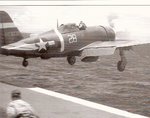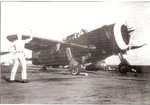Navigation
Install the app
How to install the app on iOS
Follow along with the video below to see how to install our site as a web app on your home screen.
Note: This feature may not be available in some browsers.
More options
You are using an out of date browser. It may not display this or other websites correctly.
You should upgrade or use an alternative browser.
You should upgrade or use an alternative browser.
P-47 carrier capable?
- Thread starter marshall
- Start date
Ad: This forum contains affiliate links to products on Amazon and eBay. More information in Terms and rules
More options
Who Replied?View: https://www.youtube.com/watch?v=RRGYXMs9n1s
On 23 June Manila Bay came under enemy air attack during refueling operations east of Saipan. Two fighter bombers attacked her from dead ahead, dropping four bombs which exploded wide to port. Intense anti-aircraft fire suppressed further attacks; and, as a precautionary and rather unusual move which Admiral Spruance later characterized as "commendable initiative", Manila Bay launched four of the Army P-47's she was ferrying to fly protective CAP until radar screens were clear of contacts
USS Manila Bay (CVE-61 - Wikipedia, the free encyclopedia)
.
Along with the Manila Bay, the escort carrier Natoma Bay also ferried P-47Ds of the 318th FG. The event above took place in '44
P-47s in the Marianas | Flight Journal | Find Articles at BNET.com
P-47s in the Marianas | Flight Journal | Find Articles at BNET.com
- Thread starter
- #4
Catch22
Major
Most planes could take off from carriers, but I'm not so sure they all could land on them. I'm pretty sure the P-47s could not land on them, they would have been lifted by crane onto the ship.
Wildcat
Major
Flyboy2
Senior Airman
Wow. A Jug definatly couldn't have landed on a carrier. To darn heavy. I bet they also ate up alot of space
Aaron Brooks Wolters
Brigadier General
Marshall, I'm just guessing here but if they did use a variant for carrier trials I would tend to think it would have to be the M. They made somewhat lighter, two fewer guns and so on but again I'm just stabbing in the dark. I will try to find out more.

syscom3
Pacific Historian
A P47 landing on a carrier would have damaged the deck .... but not the P47
kool kitty89
Senior Master Sergeant
The P-47 (particularly the earlier D models) wasn't all that much heavier than the Corsair, and considderably lighter than a/c like the SB2C.
However it had a relatively high landing speed, and landings would have been pretty hard. (think about what would happen to the arrestor hook and wire...)
This was due to a combination of high wing loading and a lower lift airfoil (nearly all USN a/c used the high lift NACA 23000 series), and smaller flaps.
If you enlarge the flaps (and make them fowler type), added the necessary carrier equipment, and completely removed the turbocharger system (cut over over 1,000 lbs off weight and replaced with 2-stage supercharger like on F4U) and subsequently cleaned up the fusalage a bit (with the turbo ducting now gone, reducing drag and weight) it might just have been a workable (and probably more than decent) carrier fighter.
Of course, by then you'd have a considderably different a/c, with different optimised performance characteristics. And the F4U would still be better suited, being specifically designed for it.
And remember though, they took B-25's off from a carrier.
However it had a relatively high landing speed, and landings would have been pretty hard. (think about what would happen to the arrestor hook and wire...)
This was due to a combination of high wing loading and a lower lift airfoil (nearly all USN a/c used the high lift NACA 23000 series), and smaller flaps.
If you enlarge the flaps (and make them fowler type), added the necessary carrier equipment, and completely removed the turbocharger system (cut over over 1,000 lbs off weight and replaced with 2-stage supercharger like on F4U) and subsequently cleaned up the fusalage a bit (with the turbo ducting now gone, reducing drag and weight) it might just have been a workable (and probably more than decent) carrier fighter.
Of course, by then you'd have a considderably different a/c, with different optimised performance characteristics. And the F4U would still be better suited, being specifically designed for it.
And remember though, they took B-25's off from a carrier.
kool kitty89
Senior Master Sergeant
View: https://www.youtube.com/watch?v=RRGYXMs9n1s
On 23 June Manila Bay came under enemy air attack during refueling operations east of Saipan. Two fighter bombers attacked her from dead ahead, dropping four bombs which exploded wide to port. Intense anti-aircraft fire suppressed further attacks; and, as a precautionary and rather unusual move which Admiral Spruance later characterized as "commendable initiative", Manila Bay launched four of the Army P-47's she was ferrying to fly protective CAP until radar screens were clear of contacts
USS Manila Bay (CVE-61 - Wikipedia, the free encyclopedia)
.
How and where did the P-47's flying CAP land?
And it looks like the P-47's in the youtube clip are being catapult launched.
Those P-47's were being ferried to their newly seized bases in the Marianas (as I guess it says). There was no intention for them to land back on the carrier, just be catapulted off and land ashore.
P-39's also did this, in the Pacific, in addition to P-40's as already mentioned. When P-40's were ferried across the Atlantic on the carrier Ranger on a few occasions, they flew off, IOW were not catapulted, similarly to the 700+ Hurricanes and Spitfires flown off to Malta in 1940-42 from RN, and on 2 occasions USN (USS Wasp), carriers. In a tiny handful of those cases a/c with mechanical trouble did manage to land back aboard, a Spitfire did so on one of the Wasp missions.
Late in the war the USN conducted landing trials with PBJ's (ie B-25's) on carriers. Catapulting or flying off from carriers was feasible for a broad range of WWII a/c not designed for it. Landing was harder but also feasible in a one-off emergency or trial in fairly many cases, especially on a bigger carrier. Day in/day out carrier operations with a reasonably low operational loss rate is where the purpose designed carrier plane usually had the advantage. Even somewhat successful carrier planes adapted from land planes were sometimes weak in that aspect. Needless to say the *pilots* also had to have carrier landing training; there was no attempt to do that in any of the USAAF ferry/fly off operations, usually minimal training even in the taking off part, but it usually went OK anyway.
Joe
P-39's also did this, in the Pacific, in addition to P-40's as already mentioned. When P-40's were ferried across the Atlantic on the carrier Ranger on a few occasions, they flew off, IOW were not catapulted, similarly to the 700+ Hurricanes and Spitfires flown off to Malta in 1940-42 from RN, and on 2 occasions USN (USS Wasp), carriers. In a tiny handful of those cases a/c with mechanical trouble did manage to land back aboard, a Spitfire did so on one of the Wasp missions.
Late in the war the USN conducted landing trials with PBJ's (ie B-25's) on carriers. Catapulting or flying off from carriers was feasible for a broad range of WWII a/c not designed for it. Landing was harder but also feasible in a one-off emergency or trial in fairly many cases, especially on a bigger carrier. Day in/day out carrier operations with a reasonably low operational loss rate is where the purpose designed carrier plane usually had the advantage. Even somewhat successful carrier planes adapted from land planes were sometimes weak in that aspect. Needless to say the *pilots* also had to have carrier landing training; there was no attempt to do that in any of the USAAF ferry/fly off operations, usually minimal training even in the taking off part, but it usually went OK anyway.
Joe
renrich
Chief Master Sergeant
They probably would have had to have a lot of wind also for the launch. The takeoff distance on land with zero wind, paved strip, sea level, full load of fuel and ammo for P47D-25 at 14411 pounds was 2540 feet. The TO distance for F4U4, same specs, at 12281 pounds was 630 feet.
starling
Airman 1st Class
hi all,was the corsair as fast as a jug-p47.lee.
renrich
Chief Master Sergeant
Which Corsair, which P47, what altitude, what load, what mission, too many variables for an answer.
318 FG USS Manilla Bay. Note theatre markings, stripes across the fuselage tailplanes, fin/rudder. Front of cowlings and wing tips also painted in the same colour. Ailerons as well? Presumably each squadron used a different colour. That of the 73 FS appears to have been white. Aircraft's number painted on inner side of wheel hub.
Attachments
Users who are viewing this thread
Total: 1 (members: 0, guests: 1)













